#john III of portugal
Explore tagged Tumblr posts
Text
I ship John III of Portugal and Leonor of Austria from the Spanish historical drama Carlos Rey Emperador
@leopard-skin-pillbox-hat-ok
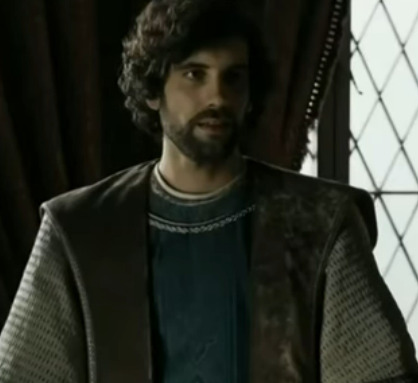
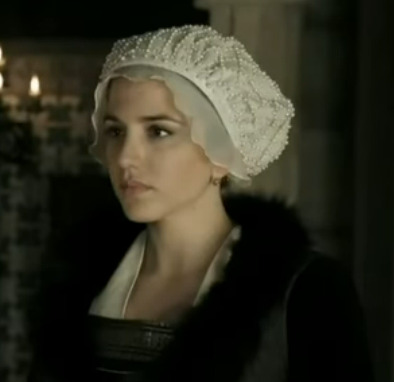
Leanor was supposed to be bethrothed to John III but she got married to his father (and her uncle) Manuel I instead. Manuel I got Leonor of Austria pregnant.
When Manuel I died and John III became king of Portugal, John III and Leonor became lovers.(or they were already lovers.. or they loved each other... coz they were of the same age and also first cousins)
John III asked Charles V, who is Leonor's brother and Holy Roman Emperor/King of Castille, for her hand in marriage. Charles V refused. Leonor was ordered to return to Castile after she gave birth to hers and Manuel I daughter.
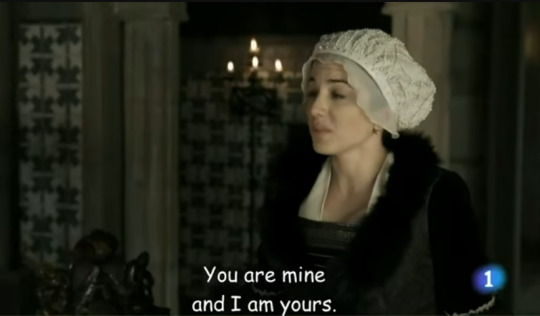
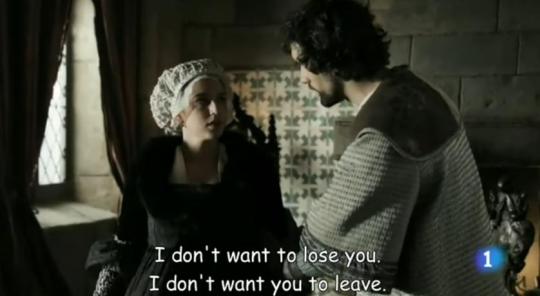
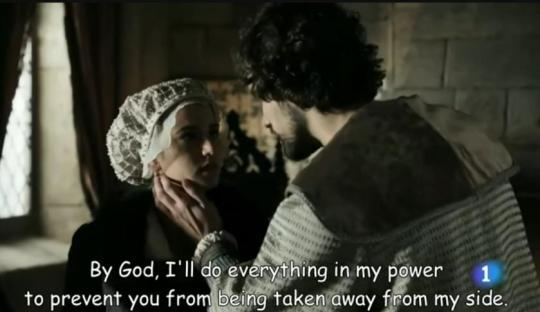
John III became a bitter and melancholic throughout his life.
Leonor never got to see her daughter again and was eventually got married to Francis I of France who didn't even lay with her :(
in a cruel twist... Charles V ordered their youngest sister Catherine to marry John III instead.
royalty is miserable business, folks.
#carlos rey emperador#leonor of austria#john iii of portugal#João III#miserable eldest daughter leonor of austria
6 notes
·
View notes
Text
#JON SNOW FORTNIGHT EVENT 2023 @asoiafcanonjonsnow
DAY 10: ECHOES OF THE PAST 🗝️📜 (1/2) ->
Historical parallels with Medieval bastard Kings.
Nowadays, ‘bastard’ is used as an insult.
Being born to unmarried parents is largely free of the kind of stigma and legal incapacities once attached to it in Western cultures, but it still has echoes of shame and sin. The disparagement of children born outside of marriage is often presumed to be a legacy of medieval Christian Europe, with its emphasis on compliance with Catholic marriage law.
Yet prior to the 13th century, legitimate marriage or its absence was not the key factor in determining quality of birth. Instead, what mattered was the social status of the parents – of the mother as well as of the father. Being born to the right parents, regardless of whether they were married according to the strictures of the church, made a child seem more worthy of inheriting parents’ lands, properties and titles.
It’s not until the late 12th century that evidence for the exclusion of children from succession on the grounds of illegitimate birth first appears. ‘Bastard’, as we now understand it, began to emerge here.
Importantly, this shift in the meaning and implications of illegitimacy did not arise as an imposition of Church doctrine. Instead, ordinary litigants began exploiting bits of Church doctrine to suit their own ends. Perhaps the earliest signs of this can be found in the annals of English legal history, with the Anstey case of the 1160s. This might have been the first time an individual was barred from inheriting because her parents had married illegally. And it happened not because the Church intervened, but because one clever plaintiff figured out how to exploit some scraps of theological doctrine. After that time, more and more plaintiffs began to do the same.
For example, towards the end of the 12th century, a regent countess of Champagne rushed to make use of an allegation of illegitimate birth against her nieces, in an effort to secure her son’s succession. Daughters could inherit in this region, and so these sisters did have a claim to the county once ruled by their late father. But the regent countess denounced the sisters as the product of an illegal marriage and therefore not legitimate heirs of their father. The strategy worked in that both daughters did eventually renounce their claims to the county, but not without first obtaining a great deal of money, enough to make them both extremely wealthy. As this suggests, the papacy had a far more passive role than is often imagined.
As bastardy began to acquire its modern meaning, in the early 13th century, it remained the case that the papacy focused on the regulation of illicit unions rather than the exclusion from succession or inheritance of those born to illicit unions. Hatred of illicit sex did trump dynastic politics on occasion. Hatred of the children born to such unions did not. There is very little evidence to suggest that an interest in keeping illegitimate children from inheriting noble or royal title outweighed political or practical considerations in the same way that the policing of illegal marriages sometimes did.
Understanding the changing meanings of bastardy helps us to arrive at a clearer picture of the workings and priorities of medieval society before the 13th century. Society then did not operate subject to rigid Christian canon law rules. Instead, it measured the value of its leaders based on their claims to celebrated ancestry, and the power attached to that kind of legitimacy. To be sure, marrying legitimately certainly received a good deal of lip service throughout the Middle Ages. Nevertheless, in this pre-13th-century world, the most intense attention was paid not to the formation of legitimate marriages, but to the lineage and respectability of mothers. Only beginning in the second half of the 12th century did birth outside of lawful marriage begin to render a child illegitimate, a ‘bastard’, and as such potentially ineligible to inherit noble or royal title.
Source
Well, George R.R. Martin has been using real life historical events as an inspiration for creating the lore of A Song of Ice and Fire, more concretely English and Western Late Medieval Europe history for Westeros, and it was precisely in the Late Middle Ages when the legal situation for bastards worsened by reinforcing marriage and legitimacy laws, reinforcing concubinates to disappear and laws to avoid any kind of polygamy.
In Westerosi society there's the stigma that comes from being born as a bastard, they're said to be born from lust, lies, and weakness, and as such, they are said to be wanton and treacherous by nature, and although they could get some prominent position either in the Citadel, the Kingsguard, Night's Watch or the Faith, they are generally discriminated by other Westerosi (except in Dorne, where there's tolerance towards bastards) and they rarely inherit his father's titles nor become kings. In the Asoiaf lore, there's recording of a bastard of a Bracken and a Blackwood, Benedict Waters, who founded the House of Justman and became King of the Trident as Benedict I; as well as Alyn Velaryon, a Velaryon bastard who was legitimised and became Lord of the Tides after The Dance of Dragons.
Till the events of the published books, Jon has reached the position as Lord Commander of the Night's Watch and King Beyond the Wall in all but in name, two positions he has been chosen for.
But he would not have the possibility to inherit any title as Lord of Winterfell and Warden of the North/King in the North as a bastard, unless someone legitimised him, like Robb did in his Will. Jon has the chance of standing as a candidate for the Northern Succession Council after defeating the Boltons.
So, if The North stays away from the Iron Throne, Jon would be a good candidate for Lord of Winterfell and King in The North, but the question is... Is there any historical example of bastards who became kings?
Yes, there are, and in this meta we're going to down through history and remember those kings. This list probably doesn't include all of the bastard kings, just a selection, if you know about some more, feel free to share it.
The most common concept for bastardy is a child born of parents who were not married when the child was born, so firstly we'll list a few kings who are included in that group, as we consider Jon as Eddard Stark's bastard or Rhaegar and Lyanna's.
Their circumstances in which those kings got to throne are diverse, but we'll get into them searching for any simmilarities between Jon's story and their lifes.
Let's start, the list is on chonological order, and we'll notice that after the 13th century the amount of bastard kings is less, like we cited at the beginning of this meta.
8th Century
-> Mauregato I of Asturias (719-788), who reigned during the late 8th century, between 783 and 788, and was the son of Alfonso I of Asturias and a Muslim concubine or servant named Sisalda. He took the throne when the nobility had declared his nephew Alfonso II of Asturias as Silo's successor, although he probablyhad support of some parts of the nobility. He wed Creusa and had a son with her, Hermenegildo. Bermudo I was elected as King of Asturias after Mauregato died.
The identity of Mauregato's mother is a bit unclear, but her being a Muslim servant is considered a common statement, so his parents followed religions, Christianism and Islam, like Rhaegar and Lyanna, the Faith and the Old Gods.
Plus as happened to Mauregato, Jon may have some problems of nobles in the Northern Great Council because he's bastard and the other candidates would have support for being legimate, although they are kids, they would need a regent, that could be beneficial for them to control the North if they want to, but maybe some other members of the Council suggest or support Jon as their leader.
11th Century
-> Ramiro I of Aragon (1006/7-1063), natural son of Sancho III of Pamplona and Sancha de Aybar. His father Sancho splited his domains and passed down one of them to his sons; from the offspring she had with his wife Muniadona of Castile: García III inherited the Kingdom of Pamplona, Ferdinand I of Leon inherited the county of Castile and Gonzalo inherited the counties of Ribagorza & Sobrarbe; and Ramiro received the county of Aragon, and he annexed the counties of Ribagorza & Sobrarbe Gonzalo died. He unified the three counties to create the Kingdom of Aragon. His relationship with his siblings was complex, due to the rivalry between them for their kingdoms, initially Ramiro tried to conquer Pamplona but he was defeated by García III, and later Ramiro allied with García and his son Sancho IV against Ferdinand I.
His reign lasted 28 years.
Ramiro married Ermesinda of Foix and Agnes of Aquitaine, their offspring was: Sancho I of Aragon & V of Pamplona, Sancha, García, Urraca and Theresa, and he had a son named Sancho out of wedlock.
-> Magnus I " the Good" of Norway and Denmark (1024 - 1047), son of Olaf II of Norway and English concubine named Alvhild. His reign lasted 12 years. When he was 4 year old, his father was dethroned by Cnut the Great, and then his family travelled through other courts seeking shelter but finally they stablished in at the court of the Grand Prince Yaroslav I of Novgorod, where he grew up, was trained as a warrior and was educated in Old Russian and Greek. Olaf was killed when he reurned to Scandinavia to fight for the throne. When Cnut left for England wife Ælfgifu and their son Svein as regents, Magnus and his supporters return to Norway and he was proclaimed king of Norway. Another son of Cnut, Harthacnut of Denmark, reclaimed Norway, but after Harthacnut died Magnus took his kingdom, but he had to face another pretender Sweyn II, Cnut's nephew, whom Magnus battled against using his father's battle axe, Hel, and he was successful, but died, and Sweyn II succeeded him as King of Denmark and Harald III as King of Norway.
-> William I the Conqueror (1028-1087), illegitimate son of Duke Robert I of Normandy and Herleva of Falaise. He was duke of Normandy and conqueror and king of England.
He started the conquest of England after his cousin, Edward the Confessor died without issue, and Harold II inherited the English throne, but he was defeated and William became the first king of England of the House of Normandy.
William and his wife Matilda of Flanders had 9 children: Robert I of Normandy, Richard, William II of England, Henry I ofEngland, Adelaide, Cecily, Matilda, Constance and Adela .
William seems to be the inspiration for Aegon I the Conqueror and his bastard brother Orys Baratheon, but he could have in common with Jon in becoming kings after their cousins died without issue (i.e. Robb) and having to defeat someone else to become kings, i.e. Jon helping Stannis to defeat the Boltons.
-> Harald III "Hen" of Denmark (1040-1080), illegitimate son of Sweyn II of Denmark and a concubine, Thora.
After Sweyn II died, Harald got elected over his brother Cnut by an assembly, and faced opposition from his brothers during his reign. He ruled over 6 years, he's known to be a peaceful ruler and introduced some monetary and legal reforms like substituting trial by combat or trial by ordeal and replace it with avsystem used by the English of calling upon honorable men to swear oaths on behalf of the parties in a trial.
Harald was married to his cousin Margareta Hasbjörnsdatter, but did not leave any heirs, and was succeeded by his brother Canute IV.
-> Cnut IV "the Holy" of Denmark (1040-1086), illegitimate son of Sweyn II of Denmark with an unknown concubine. He succeeded his brother Harald.
Cnut is considered an ambitious and strict king, ruled during 6 years, limited the power of the nobility, gave great concession and donations to the Church, and took the property of a great quantity of common land for himself or the Church. He raided England a few times and created a fleet to invade it, since he considered William I an usurper, but on his way to lead the invasion, he was killed during a peasant revolt.
After he died, he was succeeded by his brother Olaf I of Denmark.
Cnut married Adela of Flanders. They had three children: Charles I of Flanders and the twin sisters Cæcilia and Ingerid. Ingerid's descendants, the House of Bjelbo, would ascend to the throne of Sweden and Norway and Canute IV's blood returned to the Danish throne in the person of Olaf II of Denmark.
->Olaf I "Hunger" of Denmark (c. 1050 – 1095) illegitimate son of Sweyn II of Denmark with an unknown concubine.
In his early years he was set aside and mistreatred and exiled by his brothers, who Ferrer he could be a political rival against them.
He succeeded his brother Cnut IV, and his reign lasted 9 years, that were plagued by several consecutive years of crop failure and famine.
Olaf married Ingegard of Norway, they didn't have any offspring, so he was succeeded by his brother Erik I.
11th Century/12th Century
-> Erik I " Evergood" of Denmark (c. 1060 – 1103), illegitimate son of Sweyn II of Denmark with an unknown concubine.
When he was young he was a supporter of his brother Cnut IV. After Olaf died, Erik was elected as new king.
Erik reign lasted 8 years, he was well liked by people, he was considered a strapping young man and a good speaker and diplomat, and ruthless towards pirates and robbers. Erik had a reputation as a loud man who liked parties, and even killed four of his men while he was drunken during one of his parties, and so he procced to go on pilgrimsge to Holy Land, journey in which he died. His brother Niels succeeded him.
Erik married Boedil Thurgotsdatter and had one legitimate son with her, Canute Lavard, father of Vademar I of Denmark. Eric had four children out of wedlock, Erik II of Denmark, Benedict, Harald Kesja and Ragnhilde, mother of Erik III of Denmark.
-> Niels I of Denmark (c. 1065 – 25 June 1134) illegitimate son of Sweyn II of Denmark with an unknown concubine. He was the last son of Sweyn to become king.
He was described as mild and forthcoming, though not a competent ruler.
Niels married Margaret Fredkulla, and had two children with her, Inge Nielsen and Magnus I of Sweden. He had a daughter born out of wedlock, Ingerd of Denmark.
During the majority of Niels' reign, 30 years, Denmark had internal peace, only broken when his son Magnus was forced from the Swedish throne and a conflict erupted between Magnus and his cousin Cnut Lavard, due to his popularity. After Magnus slew Cnut, Erik II took his brother's place in the conflict, and Niels supported Magnus.
Niels and Magnus died during the civil war and Erik II became king of Denmark.
-> Erik II "the Memorable" of Denmark (c. 1090– 1137 ), illegitimate son of Eric I of Denmark with an unknown concubine.
Erik the Memorable rebelled against his uncle Niels, and was declared king in 1134.
He punished his adversaries severely, and rewarded his supporters handsomely, as he was considered a harsh and unpopular ruler, he only ruled Denmark 3 years. He was killed by a subject in 1137 and was promptly succeeded by his nephew Erik III of Denmark.
Erik married Malmfred of Kiev, they had no issue, but Erik had a son with his concubine Thunna, Sweyn III of Denmark.
12th Century
-> Sweyn III of Denmark (1125-1157), illegitimate son of Erik II of Denmark and a concubine named Thunna.
He was elected king after Erik III of Denmark abdicated.
In 1154, Sweyn was overthrown by an alliance between Canute and Valdemar, who was crowned Canute's co-ruler as Valdemar.
This prompted the Danish magnates to force through a tripartition of the kingdom into Jutland, Zealand, and Scania. Sweyn chose first, and was made the ruler of Scania.
After that Sweyn organised apeace banquet, in which Sweyn planned on killing his two co-rulers, and succeeded in having Canute killed, but Valdemar escaped. After that Valdemar and Sweyn battled, Sweyn was killed while he was scaping from the battle. Valdemar I was proclaimed king of all Denmark.
Sweyn married Adela of Meissen, daughter of Conrad, Margrave of Meissen, and Luitgard of Ravenstein. They had two children Erik and Luitgard, who married Berthold I of Istria.
->Tancred I of Sicily ( 1138 – 1194), or Tancred of Lecce, illegitimate son of Roger III, duke of Apulia, eldest son of Roger II of Sicily, and his mistress Emma of Lecce.
Tancred was born in Lecce and inherited the county from his grandfather.
With his bastard uncle Simon plotted to remove William II, legitimate son of Roger II, but failed and went to exile.
Years after, Tancred returned to Sicily he swore fealty to his aunt Constance I as William II's heiress, Tancred rebelled and was crowned as King of Sicily. Constance I and her husband the Holy Roman Emperor Henry IV fought against Tancred. Tancred died during the war after 5 years of reign, and was briefly succeeded by his son William III, who was soon captured and executed by orders of Henry IV.
Tancred had married Sybilla of Acerra, an their children were: Roger III, William III, Elvira, Constance, Medania and Valdrada.
13th Century
->Manfred I of Sicily (1232 – 1266), natural son of Holy Roman Emperor Frederick II with Bianca Lancia, legitimised later by his father.
Manfred became regent over the kingdom of Sicily on behalf of his nephew Conradin. As regent he subdued rebellions in the kingdom, until in 1258 he usurped Conradin's rule. After an initial attempt to appease Pope Innocent IV he took up the ongoing conflict between the Hohenstaufens and the papacy through combat and political alliances. He defeated the papal army at Foggia. Manfred was excommunicated by three successive popes, Manfred was the target of a Crusade called by the Popes Alexander IV and Urban IV.
Urban received the help of Charles of Anjou in overthrowing Manfred. Manfred was killed during his defeat by Charles at the Battle of Benevento, and Charles became King of Sicily as Charles I after having executed Conradin.
Manfred had married Beatrice of Savoy and Helena Angelina Doukaina, their children were Constance II of Sicily, Beatrice, Henry, Anselm and Frederick. He also had an illegitimate daughter, Flordelis.
His daughter Constance II married Peter III of Aragon, and with their supporters in the island of Sicily fought against Charles I, who, of the whole kingdom (the Kingdom of Sicily in that period was formed by Naples and the island of Sicily) now controlled only Naples, and Constance II and her children gained Sicily, that later became part of the Crown of Aragon, and their descendants Kings of Aragon annexed Naples some generations later, and Naples and Sicily were ruled by the same king again under the reigns of Alfonso V and his nephew Ferdinand II of Aragon & his descendants.
14th Century
-> Henry II "the Fratricidal" of Castile (1334-1379), or Henry of Trastámara, illegitimate son of Alfonso XI of Castile and his mistress Leonor de Guzmán.
Henry was the fourth of ten illegitimate children of King Alfonso XI of Castile and Eleanor de Guzmán, a great-granddaughter of Alfonso IX of León. He was born a twin to Fadrique Alfonso, Lord of Haro, and was the first boy born to the couple that survived to adulthood.
At birth, he was adopted by Rodrigo Álvarez de las Asturias. Rodrigo died the following year and Henry inherited his lordship of Noreña. His father later made him Count of Trastámara and lord over Lemos and Sarria in Galicia, and the towns of Cabrera and Ribera, which constituted a large and important heritage in the northwest of the peninsula. It made him the head of the new Trastámara dynasty, a bastard branch from the Castilian branch of House Burgundy.
Alfonso XI gave Eleanor many titles and privileges for their children. This caused discontent among many of the noblemen and in particular the queen, Maria of Portugal, and her son Peter I of Castile.
When Peter I succeeded his father, Henry and his siblings revolted several times and were on a intermittent wars during Peter I's reign, in which Henry was supported by Peter IV of Aragon and Charles V of France.
Henry had numerous lovers, Leonor Álvarez, Elvira Íñiguez, Beatriz Fernández, Beatriz Ponce de León y Jérica, Juana de Sousa, Juana de Cárcamo and Juana de Cifuentes, and had in total 13 bastard children: Alfonso, Eleanor, Joanna, Constance, Ferdinand, Mary, Fadrique, Beatrice, Henry, Peter, Isabella, Inés and Joanna.
Henry married Juana Manuel de Villena and they had three children, John I of Castile, Eleanor and Joanna.
In 1369 Henry II defeated and killed his brother Peter I, and became the first king of House Trastámara. During his 10 year reign he faced opposition from Ferdinand I of Portugal and Constance of Castile, Peter I's daughter, and her husband John of Gaunt. Henry II was succeeded by his son John I of Castile
Due to his alliance with Peter IV of Aragon, John I of Castile wed Peter's daughter, Eleanor of Aragon, two of his children were Henry III of Castile and Ferdinand I of Aragon, and so House Trastámara ruled over the Crowns of Castile and Aragon.
14th Century/15th Century
->John I "of Fond Memory" or "the Great" or "the Good" of Portugal (1357-1433), John of Avis, natural son of Peter I of Portugal and Teresa Guille Lourenço. He's the founder and first king of House of Avis, bastard branch from the Portuguese branch of House Burgundy.
His first important charge was Great Master of the Order of Avis, and years after, when Succession Crisis broke out, John ended up being crowned as King of Portugal. John I ruled Portugal over 48 years, the most extensive reign of all Portuguese monarch, and m9st of its reign was able to rule in peace and concentrate on the economic development and territorial expansion. He was succeeded by his son Edward I of Portugal.
It maybe a coincidence, but it's interesting the contrast between Jon and Ramsay, both being Northern bastards, but Ramsay it's like the personification of the Westerosi prejudices against bastards, Ramsay Bolton was legitimised and became his father's heir because he (allegedly) poisoned and killed his trueborn brother Domeric, meanwhile Jon will be KITN because Robb died due to the Bolton-Frey treason and in his will he legitimised and declared Jon as his heir, and in that way there's the parallel between Jon and Ramsay and John I of Portugal and Henry II of Castile, John seemed to have a good relationship with his brother Ferdinand I of Portugal and after the Succession war he became the next king, and Henry II didn't get along with his brother Peter I and he became king after he killed him.
This is a brief introduction, the next part of the meta it'll be dedicated fully to John I of Portugal and his parallels with Jon Snow.
15th Century
->Ferdinand I of Naples (1423-1494), illegitimate son of Alfonso V of Aragon and his mistress Gueraldona Carlino. Ferdinand I of Naples was named after his grandfather Ferdinand I of Aragon, first king of Crown of Aragon from House Trastámara.
His father had conquered Naples after defeating René I and stablished in Naples during most of the rest of his life there since he left in charge his wife and cousin Mary of Castile and his brother John for the government of Aragon when he was away in Italy. Alfonso didn't have legitimate children, he only had three children with his mistress, Ferdinand being the eldest.
So, Alfonso managed to declare his son as heir of Naples, with some alliances with the local nobility, like a marriage between Ferdinand and Isabella of Chiaramonte, and the rest of the Crown of Aragon was inherited by John II of Aragon.
Ferdinand I had to face opposition from foregain royalty and nobility and some local barons who didn't accept Ferdinand' reforms and ambitions and because he was a bastard and he limited they power, and often allied against him, like Pope Callixtus III, John of Anjou, Mariano Marzano, the Angevines, his cousin Charles of Viana (John's II eldest son, although John II accepted his nephew's kingship), among others.
John II of Aragon sent a fleet to support of his nephew against the Angevines, and when the Catalan nobility offered the Aragonese crown to René I during the Catalan civil war, sent troops in support.
Ferdinand had married Isabella of Taranto and his cousin Joanna of Aragon, their offspring was Alfonso II of Naples, Eleanor, Frederick I of Naples, John, Beatrice, Francesco and Joanna, who married his nephew Ferdinand II of Naples.
He had several children with his mistresses Diana Guardato, Marchesella Spitzata, Piscicella Piscicelli, Eulalia Ravignano and Giovannella Caracciolo: Mary, Joanna, Ilaria, Henry, Mary, Alonso, Cesare, Maria Cecilia, Lucrezia, Ferdinand, Mary and Joanna.
He was a very passionate man, he had an almost pathological attraction towards young women and, despite the numerous lovers and concubines, he loved very much his wife Isabella of Taranto, a woman of exceptional virtues, whose death greatly afflicted him. As a father he was very present and very fond of his offspring, especially known is the strong affection shown for his daughters.
Despite the odds, Ferdinand I ruled Naples during 36 years and brought peace and prosperity to Naples, although he had to deal with opponent powers like the Ottoman Empire, France, the Republic of Venice and the Papal States.
He was one of the most influential and feared monarchs in Europe at the time and an important figure of the Italian Renaissance, Ferdinand promoted Renaissance culture and art with his patronage, surrounding himself with numerous artists and writers who flourished in his kingdom, introducted the art of silk and printing, the King showed enthusiasm for music and established in Naples the first musical school in Italy and one of the first in Europe. Ferdinand expanded the very rich royal library founded by his father in Castel Capuano and grow at an impressive rate, thanks to purchases, gifts and the confiscation of the collections of the rebel barons.
He issued various social laws that undermined the excessive power of the Barons, favoring small artisans and peasants. This work of modernization and the resistance he put up against them led to the outbreak of the famous revolt which was subsequently suffocated.
Recognized as one of the most powerful political minds of the time, a very skilled diplomat, stablished the hegemony of Naples over other Italian states, and a dense network of alliances and relationships with Italian and foreign sovereigns, through marriages of his illegitimate and legitimate and children.
After Ferdinand died he was succeeded by his son Alfonso II of Naples, who in turn abdicated very soon in favor of his own son Ferdinand II of Naples.
To expand the list, there's another case of bastardy, in which their parents' marriage was declared null or invalid, if we're considering the possibility that Rhaegar and Lyanna secretly and it could be considered invalid because Rhaegar was already married to Elia and maybe the lack of credible witness make that the wedding could be considered questionable, so for a great sector of the society would be considered a bastard (i.e. The Faith).
9th Century/10th Century
->Athelstan of England (894-939), first king of England, son Edward of Wessex and Egwina. Their parents married, but due to his mother low status, their marriage got annulled. Athelstan succeeded to the throne of Wessex after his brother King Ethelweard, son of Edward and Ælfflæd of Wessex, died.
Aethelstan is known for being a great diplomat, strategist and reformer, created a strong system of alliances, istarted being king of Wessex and anexxed the other six English kingdoms: Northumbria, Mercia, East Anglia, Kent, Sussex and Essex. He never wed and ha no children, so after he died, his brother Edmund I, eldest son of Edward and his third wife, Edgiva, succeeded him.
The English Heptarchy seems to be the inspiration for the Seven Kingdoms, and it's an interesting datail that a bastard from a kingdom, started becoming king of that kingdom and then he ruled the seven kingdoms , as Jon could be proclaimed King in the North, for fighting the Others, he'll have to try to convince and unify the rest of Westeros to survive the War for the Dawn.
11th Century
->Harold I of England (1016-1040), son of Cnut the Great, King of Denmark, Norway, Sweden & England, and Ælfgifu Ælfhelmsdotter. His parents got married by the Danish law, but once Cnut converted to Cristianism and conquered England, married Emma of Normandy, who was considered as his only wife by the Church. Harthacnut, son of Cnut and Emma, left Harold as regent of England while he was away, and later Harold was proclaimed king of England. Harold ruled for four years and sixteen weeks, when he died, Harthacnut took the control of the English throne. Harold married Ælfgifu, and had a son, Ælfwine, but he became a monk.
One of the speculations within the fandom about Rhaegar and Lyanna is that there could have been a secret wedding, maybe it could have been in front of a weirwood in the Isle of Faces following the Northern wedding custumes, in contrast of Rhaegar marring Elia by the Faith of the Seven ceremony.
12th Century/13th Century
->Ferdinand III " the Saint" of Castile ( 1199/1201 – 1252), son of Alfonso IX of Leon and Berenguela I of Castile, their marriage was annulled due to the consanguinity between them. He's the first king of the Crown of Castile, his reign lasted 35 years. Ferdinand III married Beatrice of Swabia and Joan of Dammartin. His children were: Alfonso X "The Wise" of Castile, Fadrique, Ferdinand, Eleonor, Berenguela, Henry, Philip, Manuel, Mary, Ferdinand, Eleonor, Louis, Simon and John.
13th Century/14th Century
->Ferdinand IV "the Summoned" of Castile (1285 - 1312), son of Sancho IV of Castile and Maria de Molina, their marriage got annulled due to consanguinity and because Sancho was betrothed to another woman, although Pope Boniface VIII legitimised Sancho and Maria union when Ferdinand IV was already king. His reign lasted 16 years. Ferdinand IV married Constance of Portugal, their children were: Alfonso XI of Castile and Eleonor of Castile, wife of Alfonso IV of Aragon.
15th Century
-> Edward V of England (1470-1483), eldest son of Edward IV of England and Elizabeth Woodville. His siblings and him were declared as bastards by their uncle Richard III alleged that Edward and Elizabeth was null because there was a promise of marriage from Edward IV to Eleanor Talbot, to get his nephew out of succession. He didn't married and had children since he was 12 when he died.
In this case, Edward V's circumstances seems to have inspired Joffrey's as well as Young Griff and Bran's partially. Stannis states that Joffrey, Myrcella and Tommen are bastards and claims to be the rightful king of Westeros, like Richard III did with his brother's children and now he's trying to make it to the Iron Throne; Bran's part could be inspired by the Princes in the Tower event, in which Edward and his younger brother Richard were imprisioned and probably killed by orders of their uncle, and there were rumors during the following years that maybe one of the brothers scaped, fuelled with pretenders who claimed to be some of the princes, like Perkin Warbeck. In ASOIAF, Theon captures Winterfell and kills the miller's sons to pretend he has killed Bran and Rickon, although they had escaped and in the future the rest of The North is going to know they alived when they return to Winterfell; Young Griff claims to be Aegon VI, Rhaegar and Elia's baby son who was murdered by The Mountain during the Sack of King's Landing
In summary, after reading about the lives of these kings on the list, in many of them we can note the pattern of being elected in an assembly like the Danish kings or having to face adversaries that undermine their positions as kings for being bastards, sometimes by other relatives pretenders or the Church, like happened to most of them. And those are a couple of events that may happen to Jon in the future books, his rising to kingship probably being elected at the Northern Assembly, probably making negotiatons with the supporters of his other siblings i.e. Rickon being supported by the Manderlys, Sansa by Littlefinger and the Vale etc, but Jon could have the support of the Mountain Clans, the Mormonts, the Glovers, House Thenn and The Free Folk.
The meta doesn't end here, for the parallels between Jon and John I of Portugal click here.
#jonsnowfortnightevent2023#jonsnowfortnightevent#jon snow#day 10#echoes of the past#medieval bastard kings#historical parallels#canonjonsnow#canonjon#asoiaf meta#jon snow meta#william the conqueror#john i of portugal#tancred i of sicily#magnus i of norway#cnut iv of denmark#eric ii of denmark#svend iii of denmark#manfred i of sicily#ferdinand i of naples#henry ii of castile#ramiro i of aragon#mauregato i of asturias#harold i of england#ferdinand iii of castile#ferdinand iv of castile#aethelstan of england#olaf i of denmark#niels i of denmark#harald iii of denmark
74 notes
·
View notes
Text

King Philip II of Spain (1527-1598), Bust in Spanish Court Dress with the Order of the Golden Fleece
Artist: Alonso Sanchez Coello (Spanish, 1531/1532-1588)
Date: c. 1568
Medium: Oil painting
Collection: Kunsthistorisches Museum Vienna, Austria
Description
Alonso Sánchez Coello, a student of Anthony Mors, was first court painter to John III of Portugal, then to Philip II of Spain. This bust of the king is a variant of a portrait in the Prado in Madrid, also attributed to Sánchez, in which the sitter's hands can also be seen. Philip II is wearing Spanish court dress with the Order of the Golden Fleece, the symbol of the knightly order of the same name that the Habsburgs had adopted from the Burgundians. Philip II, known as "El Prudente" (= the Wise), was born in 1527 as the son of Emperor Charles V and Isabella of Portugal. In 1556 he became King of Spain. His reign brought Spain's supremacy within the European states. Philip II also suffered some major defeats: in 1579/81 the northern provinces of the Netherlands were lost, and in 1588 the Spanish Armada was defeated by England. This was offset by the acquisition of Portugal and its large colonial empire. The greatest victory of the century, however, was the destruction of the Turkish fleet at the Battle of Lepanto in 1571 under the leadership of Don Juan de Austria, a half-brother of King Philip. His four marriages to Mary of Portugal, Mary Tudor, Isabella of Valois and Archduchess Anne were in line with political goals. Philip II's conscientiousness and absolute self-control were both admired and feared.
#portrait#painting#bust painting#fine art#philip ii of spain#spanish court dress#order of the golden fleece#symbol#knightly order#spanish history#spanish monarchy#oil painting#alfonso sanchez coello#spanish painter#spanish culture#16th century painting#spanish art#artwork#european art
12 notes
·
View notes
Text
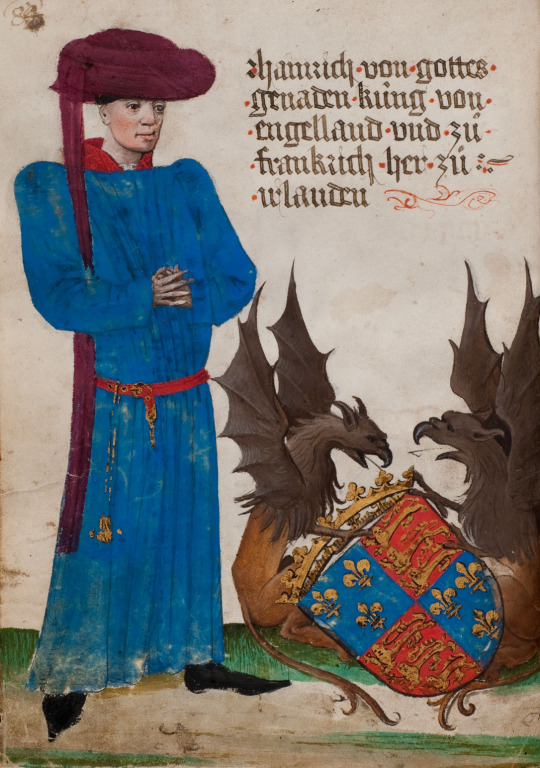
Drawing of Henry VI of England by Jörg von Ehingen.
From 1457-1459, Swabian knight Jörg von Ehingen traveled Europe participating in various campaigns; throughout, he kept a journal and sketchbook of his impressions of the many royal courts he passed through. His compilation includes portraits, in the order of his visits, of Duke Ladislaus V of Austria, Charles VII of France, Henry IV of Castile, Henry VI of England, Alfonso V of Portugal, Janus III of Cyprus, Duke René of Anjou, John II of Aragon, and James II of Scotland.
#we love a contemporaneous portrait from an eyewitness#absolutely dapper hat#you may be familiar with Alfonso V's incredible poulaine shoes and/or his terrible heraldic lion#Henry's got pretty swell poulaines himself#altho I have just noticed his lil skelly hands#plantagenets#manuscript
64 notes
·
View notes
Text
The Pretty Cures and its Saints: Wonderful Pretty Cure!
With 2024 is nearly come to its conclusion - from Switzerland ended the 36-year title drought in ESC to Trump (this sick bastard) reclaims the Commander-in-Chief title, here to share with you all with their birthday corresponding with feast days that is honored and recognized by the Roman Catholic Church!

May 13 - Komugi Inukai (Cure Wonderful)
Our Lady of Fatima: Formally known as Our Lady of the Holy Rosary of Fátima, is a Catholic (Marian) title of Mary, mother of Jesus, based on the Marian apparitions reported in 1917 by three shepherd children at the Cova da Iria in Fátima, Portugal. The three children were Lúcia dos Santos and her cousins Francisco and Jacinta Marto. José Alves Correia da Silva, Bishop of Leiria, declared the events worthy of belief on October 13, 1930. Pope Pius XII granted a pontifical decree of canonical coronation via the papal bull Celeberrima solemnia towards the venerated image on April 25, 1946. Cardinal Benedetto Aloisi Masella, the designated papal legate, carried out the coronation on May 13, 1946, now permanently enshrined at the Chapel of the Apparitions of Fátima.
August 7 - Iroha Inukai (Cure Friendy)
St. Cajetan: Italian priest and religious reformer who is known as the co-founder of the Congregation of Clerics Regular of the Divine Providence aka the Theatine order. The order grew at a fairly slow pace: there were only twelve Theatines during the sack of Rome in 1527, during which Cajetan was tortured by the Spanish soldiers of Charles V who had mutinied. Canonized as a saint by Pope Clement X in 1671, he is the patron of the unemployed, bankers, workers, gamblers, jobseekers, document controllers and gamers.
December 21 - Yuki Nekoyashiki (Cure Nyammy)
St. Peter Canisius: Dutch Jesuit priest who, known for his strong support for the Catholic faith during the Protestant Reformation in Germany, Austria, Bohemia, Moravia, and Switzerland. Through his preaching and writings, he became one of the most influential Catholics of his time. Canonized by Pope Pius XI in 1925 and declared Doctor of the Church the same year, he is the patron of Catholic press and his major shrine can be found in Fribourg, Switzerland.
November 5 - Mayu Nekoyashiki (Cure Lillian)
St. Elizabeth: She was the mother of St. John the Baptist, the wife of Zechariah and a relative of Mary, mother of Jesus, according to the Gospel of Luke and in Islamic tradition. She was past normal child-bearing age when she conceived and gave birth to John. She is also present in art when she is greeted by Mary, and is known for the Visitation, which can be found as a Second Joyful Mystery in the Holy Rosary.
September 7 - Satoru Toyama
St. Marko Stjepan Krizin (Marko Križevčanin): Croatian missionary, theology professor and Catholic priest who was active in the 17th century. He was executed in 1619 in the course of the struggle between Catholicism and Calvinism in the region. Beatified by Pope St. Pius X in 1905, and canonized by Pope St. John Paul II at Košice, Slovakia in 1995, Marko’s relics can be found at the Esztergom Basilica in Esztergom, Hungary.
March 27 - Daifuku (Daifuku Toyama)
St. Rupert of Salzburg: 8th century Austrian bishop who is the first Bishop of Salzburg and abbot of St. Peter’s in Salzburg, and was the contemporary of King Childebert III. By the end of the 7th century, the Agilolfing duke Theodo of Bavaria requested that he come to his residence at Regensburg (Ratisbon) to help spread the Christian faith among the Bavarian tribes. In Christian art, he depicted with a barrel of salt in his hand, thus he is the patron saint of salt miners.
#random stuff#catholic#catholic saints#precure#pretty cure#wonderful precure#komugi inukai#cure wonderful#iroha inukai#cure friendy#yuki nekoyashiki#cure nyammy#mayu nekoyashiki#cure lillian#satoru toyama#daifuku toyama
7 notes
·
View notes
Text








AU: Valois House. Children Francis I and Claude Valois.
Luisa(1515 - 1576). Queen of Spain and Empress of the Holy Roman Empire. Wife of Charles V. Despite the fact that the age difference between the spouses was 16 years, they loved each other. Charles treated his young wife with tenderness. She was interested in music, dancing and writing. Luisa and Charles had 7 children: John III, Claude, Philip, Ramiro, Ferdinand, Joana, Charles.
Charlotte(1516 - 1570). Queen of Portugal. Wife of Juan III and mother of 6 children: José I, Manuel, Isabella, Sancho, Aldegunda, Mary. Charlotte devoted much time to the education of her children and the enlightenment of the Portuguese court. She was the favorite sister of Francis II and maintained a close relationship with his wife.
Francis II(1518 - 1590). King of France. Husband of Mary Tudor. Francis loved his wife. Unlike his father and brothers, he never had mistresses or children out of wedlock. The reign of Francis II was an era of prosperity and rise. Father of 8 children: Claude, Francis III, Catherine, Charlotte, Tristan, Raoul, Adele, Henry.
Henry(1519 - 1587). Duke of Orleans. Husband of Catherine de Medici and father of 10 children: Francis, Elizabeth, Claude, Louis, Charles, Henry, Margaret, Hercule, Victoria and Jeanne. All his life loved only his mistress Diana de Poitiers, even wanted to marry her, but because of pressure from his father did not do it.
AU: дом Валуа. Дети Франциска I и Клод Валуа.
Луиза(1515 - 1576). Королева Испании и императрица Священной римской империи. Жена Карла V. Несмотря на то, что разница в возрасте между супругами была 16 лет, они любили друг друга. Карл с нежностью относился к молодой жене. Интересовалась музыкой, танцами и писательством. У Луизы и Карла родилось 7 детей: Хуан III, Клод, Филипп, Рамиро, Фердинанд, Хуана, Карл.
Шарлотта(1516 - 1570). Королева Португалии. Жена Жуана III и мать 6 детей: Жоз�� I, Мануэль, Изабелла, Саншу, Альдегунда, Мария. Шарлотта уделяла много времени образованию своих детей и просвящению Португальского двора. Была любимой сестрой Франциска II и поддерживала близкие отношения с его женой.
Франциск II(1518 - 1590). Король Франции. Муж Марии Тюдор. Франциск любил свою жену. В отличие от отца и братьев у него никогда не было любовниц и внебрачных детей. Правление Франциска II было эпохой процветания и подъёма. Отец 8 детей: Клод, Франциск III, Екатерина, Шарлотта, Тристан, Рауль, Адель, Генрих.
Генрих(1519 - 1587). Герцог Орлеанский. Муж Екатерины Медичи и отец 10 детей: Франциск, Елизавета, Клод, Людовик, Карл, Генрих, Маргарита, Эркюль, Виктория и Жанна. Всю жизнь любил только свою любовницу Диану де Пуатье, даже хотел на ней жениться, но из-за давления отца не стал этого делать.
Part 1.
#history#history au#royal family#royalty#au#france#france history#History of France#French royal family#french#french royalty#french royal family#French royal#Royal#Royals#the tudors#henryviii#mary tudor#the serpent queen#catherine de medici#mary stuart#Henryii#francis valois#The reign#elizabeth i#15th century#16th century#Francis i#Francisii#French kings
29 notes
·
View notes
Text

La Fiesta de San Juan, también llamada Víspera de San Juan o Noche de San Juan, es la celebración que tiene lugar anualmente en la víspera de la festividad cristiana del nacimiento de San Juan Bautista el día 24 de junio.12
Algunos vinculan la festividad, o algunas de sus celebraciones, a ritos de origen pagano previos o ajenos al cristianismo (Litha), reminiscencia de sacrificios humanos.34 En países europeos-mediterráneos la realización de hogueras suele ser un elemento habitual.
Se celebra en muchos puntos de Europa, aunque está especialmente arraigada en las áreas periféricas: Inglaterra (Midsummer o St. John's Eve), Irlanda, España, Portugal (fogueiras de São João), Noruega (Jonsok), Dinamarca (Sankthans), Suecia (Midsommar), Finlandia (Juhannus), Estonia (Jaanipäev). En Sudamérica (donde se acerca al solsticio de invierno) es festejada especialmente en el nordeste de Argentina, Brasil (tiene Festas Juninas), Bolivia, Colombia, Cuba, Chile, Ecuador, Paraguay, Perú, Puerto Rico y Venezuela, donde la noche de San Juan está así mismo relacionada con antiquísimas tradiciones y leyendas españolas como la Leyenda de la Encantada.
Significado religioso
Esta celebración de San Juan Bautista se da debido a que es el santo que está junto al niño Jesús y el único del que se celebra el nacimiento. En la historia sagrada, San Juan Bautista es el primo de Jesús, que anuncia el nacimiento del Mesías y por eso se le considera su precursor. No es casualidad que su fiesta se celebre justo seis meses antes de la Natividad de Jesús. En varios lugares, para honrar al santo se construyen altares en las casas privadas que se pueden visitar durante la noche del 23 al 24 de junio. También son frecuentes las fiestas populares nocturnas en la noche del 23, acompañadas de muchos repiques de tambor y bebidas espirituosas con las que se le da inicio a la festividad, y son tradición, probablemente precristiana, las hogueras. En la mañana del día 24,5 el santo es sacado del lugar donde estuvo guardado durante un año y es llevado sobre la cabeza o en los hombros de quien es nombrado su guardián que en este caso es el dueño del lugar donde estuvo resguardado, es un recorrido que se hace por todo el pueblo o comunidad donde realizan la celebración hasta llegar a la iglesia donde culminan con la celebración de una misa y el fabuloso repique de los tambores. Los fieles esperan al caer la noche para realizar algunos rituales que le dan protagonismo al día, uno de ellos es cortarse el cabello para que crezca fortalecido, otro es colocar un huevo en un vaso de agua y de esa manera tener conocimiento de su futuro, también se dice que ese día el agua adquiere propiedades beneficiosas, las plantas cualidades milagrosas y curativas, así como otras ceremonias que son realizadas por los creyentes con mucha fe, luego se deja el santo en la iglesia y el pueblo se dedica a celebrar toda la noche bajo el toque de tambores.
La fiesta cristiana de San Juan es el 24 de junio, seis meses antes de la víspera del nacimiento de Jesús, que se situaba el 25 de diciembre (según el calendario romano, ambas fiestas se sitúan en el octavo día antes de las calendas de enero y julio, respectivamente). Estos seis meses son la diferencia que los evangelios indican entre uno y otro nacimiento. No obstante, tres días de diferencia de ambas fechas con ambos solsticios hace que no sea razonable asignar esta fiesta al solsticio (aunque es cierto que en el III siglo el 25 de diciembre, octava ante calendas de enero, se celebraba la fiesta romana del Sol Invicto) así que los estudiosos se inclinan por el hecho de que el 25 de diciembre, nacimiento de Jesús, se asocia también con la celebración judía de la Hanukkah o dedicación del Templo (Jesús era el nuevo Templo para los cristianos); pero existen también otras teorías, según las cuales la muerte de Jesús se habría producido el mismo día de su concepción y esta fecha, que también coincidía con la de la creación del mundo, se situaba el 25 de marzo; por tanto el nacimiento, nueve meses más tarde, habría tenido lugar el 25 de diciembre. Según este razonamiento, la colocación de la fiesta de San Juan no estaría directamente relacionada con las celebraciones paganas del solsticio de verano, aunque de alguna forma sirviese también para reconducirlas al universo de referencia cristiano.
Vinculación con el solsticio de verano.
La llegada del solsticio de verano se celebra en toda la geografía española con ritos y tradiciones ancestrales. Algunos piensan que San Juan es la noche más corta del año (en el hemisferio norte) o la más larga (en el sur), aunque en realidad esto suele ocurrir el día 21 de junio, por lo que en muchas localidades se celebran fiestas que duran hasta el amanecer y en las que el fuego y las hogueras tienen un papel especial. La noche de San Juan ha adquirido la magia de las antiguas fiestas paganas que se organizaban con el solsticio de verano.6
El origen de esta costumbre se asocia con las celebraciones en las que se festejaba la llegada del solsticio de verano, el 21 de junio en el hemisferio norte, cuyo rito principal consiste en encender una hoguera. La finalidad de este rito era "dar más fuerza al sol", que a partir de esos días iba haciéndose más "débil" ―los días se van haciendo más cortos hasta el solsticio de invierno. Simbólicamente, el fuego también tiene una función "purificadora" en las personas que lo contemplaban.
En muchos lugares no cabe duda de que las celebraciones actuales tienen una conexión directa con las celebraciones de la antigüedad ligadas al solsticio de verano, influidas por ritos precristianos o simplemente vinculados a los ciclos de la naturaleza. Sin embargo, en otros lugares (por ejemplo, España y Portugal) la existencia de una vinculación entre las celebraciones del solsticio de verano (en el hemisferio norte) que tiene lugar el 20-21 de junio y las celebraciones del día de San Juan (el 24 de junio) varían en función de las fechas, la discontinuidad en la celebración, las tradiciones y costumbres o la ruptura con el pasado precristiano que supuso el largo período de dominación musulmana en la península ibérica, que haría imposible cualquier vinculación con cultos paganos de una festividad vinculada al cristianismo (pero en realidad los musulmanes no intervinieron directamente sobre las costumbres religiosas del pueblo cristiano, como testimonia la conservación del culto mozárabe en Toledo). Pese a ello, se observan elementos comunes, como la realización de hogueras en las calles y plazas de las poblaciones donde se reúnen familiares y amigos.
La vinculación de los ritos ligados al solsticio de verano con otra celebración popular y bastante extendida del mes de junio, las «verbenas de San Pedro» (el 29 de junio, día que el santoral cristiano otorga al primer papa), resulta aún menos clara.
Disputa sobre la fecha
En aquellos lugares donde la celebración se liga a la fiesta de San Juan (24 de junio) y no a la efeméride astronómica del solsticio de verano (21-22 de junio) existe una disputa sobre cuál es la auténtica "noche de San Juan". Si bien cabe entender que a partir de las 0:00 horas ya se trata del 'día de San Juan' y, por tanto (al ser de noche en las zonas lejanas al círculo polar ártico) esas primeras horas puedan más de lo habitual es entender que la noche de un determinado día no se refiere a las primeras horas del mismo, sino a las últimas, una vez que ya se ha puesto el Sol. Ello además se refuerza con el uso tradicional del concepto de "noche" donde la "noche del lunes" es la que va del lunes al martes y no la del domingo al lunes. Esta diferente interpretación da lugar a que en algunas regiones (p.ej. Almería, La Coruña o Barcelona) las celebraciones tengan lugar la noche del 23 al 24 de junio mientras que otras la noche del 24 al 25 (ej. Hogueras de Alicante). Por otro lado, no es extraño que en algunas partes la celebración se extienda a las dos noches en función del espíritu festivo de cada sitio.
Wikipedia
10 notes
·
View notes
Text

Albert Gregorius - Portrait of King Joao VI - 1826
Dom John VI (Portuguese: João VI; 13 May 1767 – 10 March 1826), nicknamed "the Clement", was King of the United Kingdom of Portugal, Brazil and the Algarves from 1816 to 1825. Although the United Kingdom of Portugal ceased to exist de facto beginning in 1822, he remained its monarch de jure between 1822 and 1825. After the recognition of the independence of Brazil under the Treaty of Rio de Janeiro of 1825, he continued as King of Portugal until his death in 1826. Under the same treaty, he also became titular Emperor of Brazil for life, while his son, Emperor Pedro I, was both de facto and de jure the monarch of the newly independent country.
John VI was born in Lisbon in 1767 during the reign of his maternal grandfather, King Dom Joseph I of Portugal. He was the second son of the Princess of Brazil and Infante Peter of Portugal, who later became Queen Dona Maria I and King Dom Peter III. John became heir to the throne when his older brother, Prince José, died of smallpox in 1788 at the age of 27. Before his accession to the Portuguese throne, John bore the titles Duke of Braganza, Duke of Beja, and Prince of Brazil. From 1799, he served as prince regent due to the mental illness of his mother. In 1816, he succeeded his mother as monarch of the Portuguese Empire, with no real change in his authority, since he already possessed absolute powers as regent.
One of the last representatives of absolute monarchy in Europe, John VI lived during a turbulent period; his reign never saw a lasting peace. Throughout his period of rule, major powers, such as Spain, France and Great Britain, continually intervened in Portuguese affairs. Forced to flee across the Atlantic Ocean to Brazil when troops of the Emperor Napoleon I invaded Portugal, he found himself faced there with liberal revolts; he was compelled to return to Europe amid new conflicts. His marriage was no less conflictual, as his wife Carlota Joaquina of Spain repeatedly conspired against her husband in favor of personal interests or those of her native Spain.
John lost Brazil when his son Pedro declared independence, and his other son Miguel (later Miguel I of Portugal) led a rebellion that sought to depose him. According to recent scholarly research, his death may well have been caused by arsenic poisoning. Notwithstanding these tribulations John left a lasting mark, especially in Brazil, where he helped to create numerous institutions and services that laid a foundation for national autonomy, and many historians consider him to be a true mastermind of the modern Brazilian state. John's contemporaries viewed him as a kind and benevolent king, although later generations of Portuguese and Brazilians have made him the subject of frequent caricature.
Albert Jacob Frans Gregorius, or Albert Jacques François Grégorius (26 October 1774, Bruges - 25 February 1853, Bruges) was a Flemish-Belgian portrait painter and Director of the art academy in Bruges.
16 notes
·
View notes
Note
Hi! I don't know how much you're interested in the subject today, but considering how i really adored a lot of your opinions/views of the Wars of the Roses and some people involved, especially Richard III, i was wondering how you think a scenerio where Richard remained King for more time or simply won Bosworth would be
Thank you for the teresting question.
Contrary to historical fiction works that portray him as desperate at the Battle of Bosworth, I think it's more likely Richard was hoping to get rid of Henry Tudor quickly and saw him as just a temporary nuisance. If only the battle had happened a couple of days later, when Richard got reinforcements from the North, or if William Stanley had not made the decision to definitely switch sides to Henry, the battle would've probably gone completely differently.
Below is my speculation of what happens if Richard wins:
The immediate outcome seems relatively clear - we know now that Richard was in the middle of secret negotiations with the royal family of Portugal for a double marriage between him and Infanta Joanna, and Elizabeth of York and King's 16-year old cousin Manuel, Duke of Beja, which were apparently going very well. It seems unlikely that Joanna, who had been refusing to get married for so long, would accept, but supposedly the negotiations were going well. We know Richard had sent her a personal letter, so it's fun to speculate what he said that would make her reconsider. I'm thinking he may have talked about religion (as they were both known to be pious) and pitched the marriage in terms of a partnership, and how she could do good for peace and the people of England through charity work (which she was known to do) and maybe even assured her that she wouldn't have to keep having children after she gave birth to an heir? Richard was expected to remarry and have a son after his only legitimate son and his wife died, but going by his choice of bride, he was looking for a great Queen and political partner above all, and not a broodmare - I can't imagine Joanna, who wanted to be a nun and was against marriage, agreeing to keep popping up a child every year or two until she hits menopause. He also may not have been two concerned because he had an heir and spares already, even though not 'of his body'- - his adult nephew John de La Pole and his younger brothers William, Edmund and Richard. The Portugal double marriage would've been a genius political move for many reasons: it would allow Richard to claim that he was ending the York/Lancaster rift for good by marrying Joanna, since the Portuguese royal family were through the female line the main surviving Lancastrian branch; it would fulfil his promise to Elizabeth Woodville that he would find good matches for her daughters in spite of their new 'bastard' status - and how! a Portuguese royal marriage was worthy of a princess* - and could be seen as healing the rift between the Yorkists too (and would at the same time make it impossible for Henry Tudor or anyone else to try to claim the throne of England by marrying her); and it would give England a great, intelligent and respectable Queen, who had experience in ruling as regent and could rule in RIchard's absence when he spent time abroad in wars, and whose reputation for piety and charity for people would help restore his tarnished reputation.
One interesting consequence of his marriage alliance is that Elizabeth of York would eventually have become a Queen Consort, but of Portugal, as Manuel eventually became King.Manuel I in 1495.
Once the situation became more stable, Richard would've probably focused on the things he had already started to do during his short reign - legal reforms aimed mostly at bettering the judiciary and the status of common people, and he would no doubt also want to curtail the power of major noblemen of questionable loyalty such as the Stanleys - and things he is known to have enthusiastically talked about planning to do, such as trying to convince other European countries to mount a campaign to stop the Ottoman Empire's conquests in Europe. (France would be an unlikely ally, Portugal and Burgundy would be obvious ones, and he'd no doubt try to pitch it to the Holy Roman Empire.)
I don't know whether he'd be successful at that, or how long he would live, but a few most obvious historical consequences would be:
the way the previous few decades were remembered in history would be very different, and no one would ever call them the "Wars of the Roses" - which was a name given by Walter Scott in the 19th century based on the fact that Henry VII used the red-white Tudor rose as his sigil, promoting it as a sign of supposed unity between the Lancaster and York dynasties - in spite of the fact that the Lancasters didn't actually use a red rose, or any kind of rose, as their sigil. Henry VII also presented the conflicts that had gone on as a part of one ongoing conflict that he ended with the Battle of Bosworth and by marrying Elizabeth of York. In reality, these were a few conflicts separated by years or even decades in between, and before the battle of Bosworth, the last actual armed conflict fought over the throne of England had been 14 years earlier, when Edward IV won his second and decisive war over the Lancasters. The conflict between the two Yorkist factions after Edward's death did not result in any actual battle (in 1783, Buckingham failed to ignite a rebellion, and his ally Henry turned back to France, realizing the war was lost before it began), so Henry basically 'ended the Wars of the Roses' only after he restarted them in 1485. (Not to mention that Henry had to fight another battle two years later against the Yorkists led by Jon de la Pole, which is always conveniently left out in history books, and had to catch, exile or execute various Yorkist pretenders throughout his reign.) If Henry loses the battle, he becomes only a footnote in history. Edward IV remains considered the one who ended the Lancaster-York conflicts with his decisive victory in 1471. Richard probably manages to be popular and respected king (much more than Henry was with his notorious tax laws) and would likely have claimed to have 'united the York and Lancaster branches' with his marriage to Joanna (though he probably wouldn't have made a huge deal out of it as Henry did, since Henry was promoting himself as the founder of a new dynasty that would start a new era). But what of the Princes in the Tower? Well, we don't know what happened to them and Richard may be suspected to have murdered them, but Henry definitely did imprison 11 year old Edward of Warwick and keep him locked up in the Tower until he was 25 and then executed him on trumped up treason charges just because he was another pretender to the throne, but barely anyone talks about it or cares, so... (insert something about history being written by the winners)
Scotland and England remain separate independent countries. It's very unlikely that the same chain of events would happen where the daughter of a king of England marries a king of Scotland, and then a century later her descendant becomes not just the king of Scotland but also the heir to the throne of England because the ruling dynasty of England died out. There is never a Tudor dynasty, never a Stuart dynasty, never a Hanover dynasty. And there's never a United Kingdom.
There is never such a thing as Anglicanism/the Church of England, with the monarch as its head. Mind you, this doesn't necessarily mean that England remains fully or predominantly Catholic - Protestantism was gaining popularity not just in England (even when Henry was still a devout Catholic) but also in Scotland, which didn't have a Henry VIII splitting with the Pope so he could annul his marriage. It's impossible to tell how exactly the Reformation and Counter-reformation would've affected England under different monarchs and a different dynasty, since so much of the religious strife in the 16th century was linked to Henry's decisions, his break from the Pope, his marriages and annulments and his succession issues, and then with the personalities and backgrounds of his children: Edward as a staunch Protestant (just like his mother's family), Mary as a staunch Catholic (completely unsurprising with her background and the fact that her father broke from the Pope so he could annul his marriage to her mother, proclaiming her a bastard), and then Elizabeth, who couldn't be tolerant to Catholics even if she didn't care about religion, since the Pope and therefore all Catholics considered her a bastard and an illegitimate monarch. How would elderly Richard, and/or his heirs, treat Protestants? What would they think of Martin Luther, or of William Tyndale? It's impossible to tell. He was a devout Catholic, but Protestantism didn't exist at the time, and would he (who was the first of English kings to publish official state documents in English) hate the idea of translating the Bible into English so ordinary people could understand it without the help of clergy? I really don't know, and it's even harder to tell what his heirs would be like in that regard. Would there be more religious tolerance in England? For all we know, it might even be less if a particularly fanatical monarch ended up on a throne... but at least I think I can say with some certainty that English monarchs of this hypothetical York dynasty would have no personal and dynastic reasons to persecute either Protestants or Catholics the way monarchs of the Tudor dynasty had due to their specific circumstances.
#richard iii#english history#henry vii#the wars of the roses#battle of bosworth#the tudor dynasty#edward iv#elizabeth of york#henry viii#church of england#english reformation#wars of the roses
14 notes
·
View notes
Text






Royal Deaths in History - 17th September
1322 - Robert III of Flanders.
1422 - Constantine II of Bulgaria.
1632 - Susenyos I, Emperor of Ethiopia.
1665 - Felipe IV, King of Spain & Portugal.
1679 - John Joseph of Austrian, Spanish general and illegitimate son of Felipe IV of Spain (Regent of Spain, Governor of South Netherlands).
1767 - Prince Edward of Wales, Duke of York and Albany, son of Frederick, Prince of Wales.
6 notes
·
View notes
Text
SAINT OF THE DAY (December 3)

On December 3, the Roman Catholic Church honors St. Francis Xavier, one of the first Jesuits who went on to evangelize vast portions of Asia.
Francis Xavier was born on 7 April 1506 in the Kingdom of Navarre, a region now divided between Spain and France.
His mother was an esteemed heiress while his father was an adviser to King John III.
While his brothers entered the military, Francis followed an intellectual path to a college in Paris. He studied philosophy and later taught it after earning his masters degree.
In Paris, the young man would discover his destiny with the help of his long-time friend Peter Faber and an older student named Ignatius Loyola — who came to Paris in 1528 to finish a degree and brought together a group of men looking to glorify God with their lives.
At first, personal ambition kept Francis from heeding God's call. Ignatius' humble and austere lifestyle did not appeal to him.
But the older student, who had undergone a dramatic conversion, often posed Christ's question to Francis:
“What will it profit a man to gain the whole world and lose his own soul?”
Gradually, Ignatius convinced the young man to give up his own plans and open his mind to God's will.
In 1534, Francis Xavier, Peter Faber, and four other men joined Ignatius in making a vow of poverty, chastity, and dedication to the spread of the Gospel through personal obedience to the Pope.
Francis became a priest in 1537. Three years later, Pope Paul III confirmed Ignatius and his companions as a religious order — the Jesuits.
During that year, the king of Portugal asked the Pope to send missionaries to his newly-acquired territories in India.
Together with another Jesuit, Simon Rodriguez, Francis first spent time in Portugal caring for the sick and giving instruction in the faith.
On his 35th birthday, he set sail for Goa on India's west coast.
There, however, he found the Portuguese colonists causing disgrace to the Church through their bad behavior.
This situation spurred the Jesuit to action.
He spent his days visiting prisoners and the sick, gathering groups of children together to teach them about God, and preaching to both Portuguese and Indians.
Adopting the lifestyle of the common people, he lived on rice and water in a hut with a dirt floor.
Xavier's missionary efforts among them often succeeded, though he had more difficulty converting the upper classes and encountered opposition from both Hindus and Muslims.
In 1545, he extended his efforts to Malaysia, before moving on to Japan in 1549.
Becoming fluent in Japanese, Francis instructed the first generation of Japanese Catholic converts.
Many said that they were willing to suffer martyrdom rather than renounce the faith brought by the far-flung Jesuit.
St. Francis Xavier became ill and died on 3 December 1552, while seeking a way to enter the closely-guarded kingdom of China.
He was beatified by Paul V on 25 October 1619.
On 12 March 1622, both Francis Xavier and Ignatius Loyola were canonized by Pope Gregory XV.
Pius XI proclaimed him the "Patron of Catholic Missions."
9 notes
·
View notes
Text
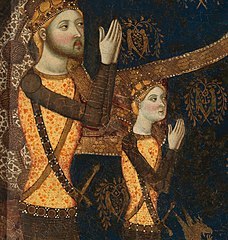

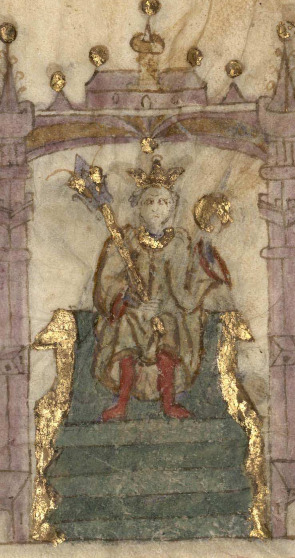
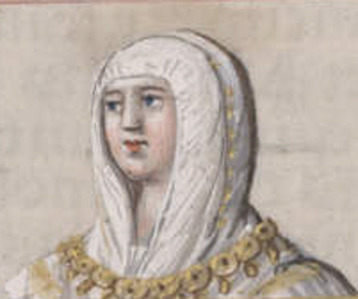
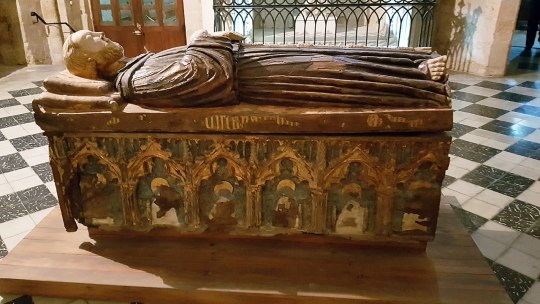
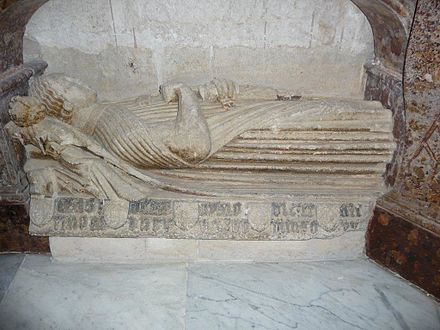

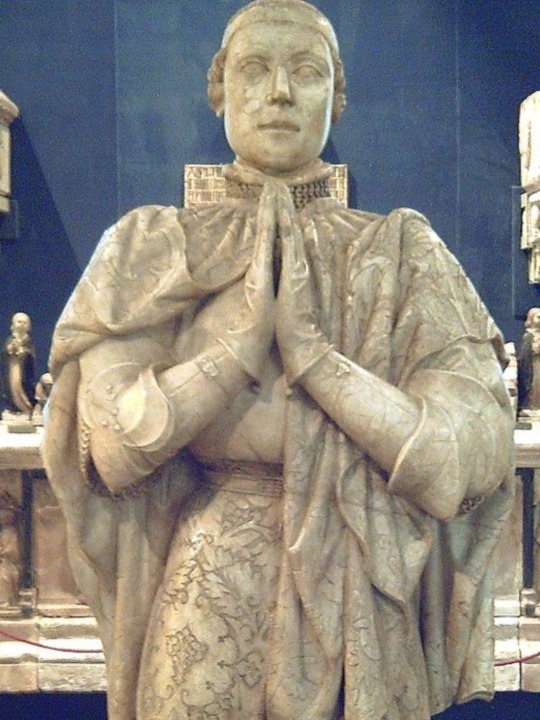
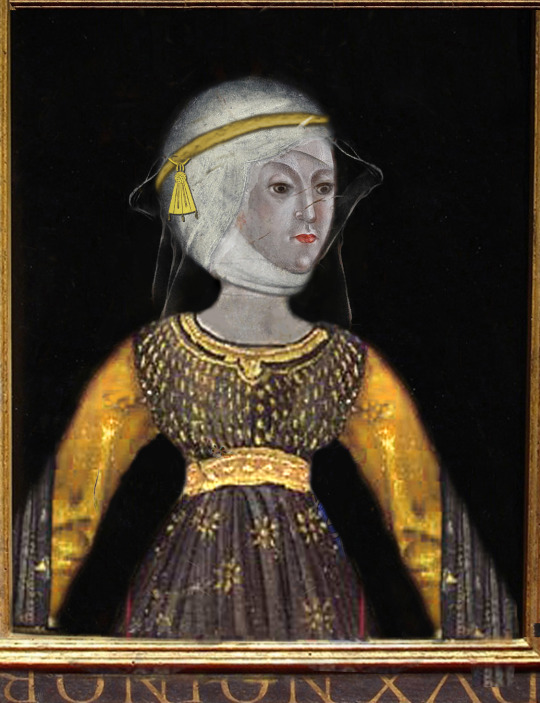
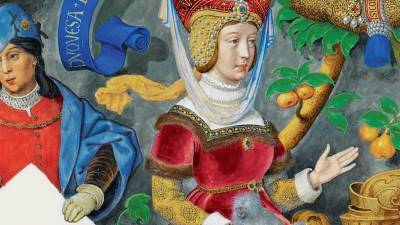
The Bastard Kings and their families
This is series of posts are complementary to this historical parallels post from the JON SNOW FORTNIGHT EVENT, and it's purpouse to discover the lives of medieval bastard kings, and the following posts are meant to collect portraits of those kings and their close relatives.
In many cases it's difficult to find contemporary art of their period, so some of the portrayals are subsequent.
1) Henry II of Castile ( 1334 – 1379), son of Alfonso XI of Castile and Leonor de Guzmán; and his son with Juana Manuel de Villena, John I of Castile (1358 – 1390)
2) His wife, Juana Manuel de Villena (1339 – 1381), daughter of Juan Manuel de Villena and his wife Blanca de la Cerda y Lara; with their daughter, Eleanor of Castile (1363 – 1415/1416)
3) His father, Alfonso XI of Castile (1311 – 1350), son of Ferdinand IV of Castile and his wife Constance of Portugal
4) His mother, Leonor de Guzmán y Ponce de León (1310–1351), daughter of Pedro Núñez de Guzmán and his wife Beatriz Ponce de León
5) His brother, Tello Alfonso of Castile (1337–1370), son of Alfonso XI of Castile and Leonor de Guzmán
6) His brother, Sancho Alfonso of Castile (1343–1375), son of Alfonso XI of Castile and Leonor de Guzmán
7) Daughters in law:
I. Eleonor of Aragon (20 February 1358 – 13 August 1382), daughter of Peter IV of Aragon and his wife Eleanor of Sicily; John I of Castile's first wife
II. Beatrice of Portugal (1373 – c. 1420) daughter of Ferdinand I of Portugal and his wife Leonor Teles de Meneses; John I of Castile's second wife
Son in law:
III. Charles III of Navarre (1361 –1425), son of Charles II of Navarre and Joan of Valois; Eleanor of Castile's huband
8) His brother, Peter I of Castile (1334 – 1369), son of Alfonso XI of Castile and Mary of Portugal
9) His niece, Isabella of Castile (1355 – 1392), daughter of Peter I of Castile and María de Padilla
10) His niece, Constance of Castile (1354 – 1394), daughter of Peter I of Castile and María de Padilla
#jonsnowfortnightevent2023#henry ii of castile#john i of castile#juana manuel de villena#eleanor of castile#alfonso xi of castile#leonor de guzmán#tello alfonso of castile#sancho alfonso of castile#peter i of castile#constance of castile#isabella of castile#asoiaf#a song of ice and fire#day 10#echoes of the past#historical parallels#medieval bastard kings#bastard kings and their families#eleanor of aragon#beatrice of portugal#charles iii of navarre#canonjonsnow
18 notes
·
View notes
Text
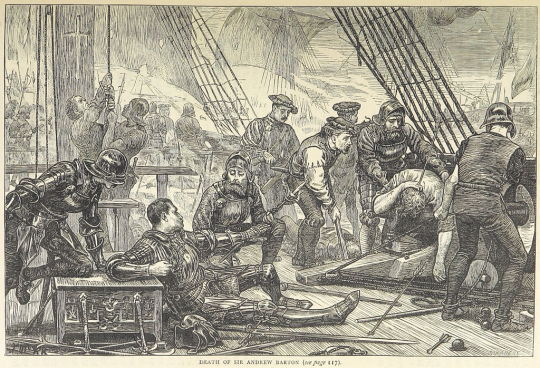

On August 2nd 1511 Scottish sailor Andrew Barton died.
Sir Andrew Barton as he is so often called, although there is no record of his ever being knighted, was among the most famous and daring sea-captains of his time.
Barton flourished during the reign of James IV, and belonged to a family which for two generations had produced able and successful seamen, Sir Andrew, as he is known although there are no records of him ever being Knighted and his brother Robert are widely recognised as the real founders of the Scotch navy. Andrew became notorious in England and Portugal as a ‘pirate’, though as a seaman who operated under the aegis of a letter of marque on behalf of the Scottish crown, he may be described as a privateer. The letter of marque against Portuguese shipping was originally granted to his father John Barton by James III of Scotland before 1485. John’s ships had been attacked by Portuguese vessels when he was trading at Sluis in Flanders.
His family is said to have taken part in a personal war with the Portuguese but it is by no means only them that the Bartons fought with on the North Sea, i found this excerpt about the run ins with the Dutch, or as they are called in the story, “The Hollanders”
In the summer of 1506, James IV appointed Admiral Sir Andrew to the command of a large, costly, and newly-built ship, and ordered him to avenge a flagrant act of injustice and cruelty committed by the people of Holland. The Hollanders had seized some Scottish ships and thrown the merchants and mariners into the sea. Sir Andrew retaliated by taking several of the Hollanders’ ships, sent to Scotland several barrels filled with the heads of the offenders, and returned himself with much booty and renown. (The writer of the Barton-Stedman Memoir excuses this bloody and barbarous act of Sir Andrew as being not unusual for that rough and turbulent time.)
In 1508, he was detained by Dutch authorities at Veere. James IV had to write to Maximilian, the Holy Roman Emperor, and others to get him released in 1509. In 1511, Andrew Barton was cruising the English coast looking for Portuguese prizes when he and his ships the Lion and Jenny Pirwyn were captured after a fierce battle with Sir Edward Howard and his brother Thomas Howard, 3rd Duke of Norfolk, off Kent at the Downs. According to the story told in ballads, Andrew was subsequently beheaded. If true, such action would perhaps have been illegal because Barton possessed a letter of marque. Contemporary English and Scottish chronicle accounts agree that Andrew died of wounds received in the fight.
I refer back to a previous posts, where James IV declared war on England, and mentioned part of the reason being the English seized two ships, this no doubt was one of them. George Buchanan, the historian and tutor of King James IV wrote that Barton continued fighting after his leg was broken by a gunshot, and encouraged his sailors by beating a drum before he died from his wounds. Buchanan emphasises that the Howards sailed on the instruction of Henry VIII following a representation by a Portuguese ambassador.
Andrew Barton appears in tow of the Child Ballads, one was originally 82 verses long, but don’t worry I’ll only subject you to a wee bit of Ballad 167, where "Sir Barton" says:
"I am hurt, but I am not slaine;
I'le lay mee downe and bleed a-while,
And then I'le rise and fight againe."
12 notes
·
View notes
Text

John, Prince of Portugal (1537-54)
Artist: Workshop of Antonis Mor (Netherlandish, 1519–1575)
Date: c. 1552-1554
Medium: Oil on canvas
Collection: Royal Trust Collection, United Kingdom
Description
John, Prince of Portugal (1537-54) was the only surviving son of King John III and Queen Catherine of Portugal. He married Joanna of Austria, sister of Philip II of Spain, in December 1552. John died in January 1554 aged sixteen, shortly before the birth of his son Sebastian, who succeeded as King of Portugal.
This portrait is a contemporary replica of a lost original portrait by Anthonis Mor. The original portrait, created in 1552 when the sitter was fourteen, belonged to Mary of Hungary (it was destroyed by fire at the palace of El Pardo in 1604). This is one of two known replicas which were created by Mor’s workshop. Both would have been executed under the artist’s direct supervision in Portugal.
Therefore, despite being a replica, this portrait is very close to the lost original, and it has a remarkable history. It is thought to be the replica created in order to be sent to Joanna of Austria by the Queen of Portugal as part of the marriage negotiations. After the death of Joanna of Austria in 1573 this portrait passed into the collection of her brother, Philip II of Spain. At the time of Philip’s death it was on loan to his sister, the Empress Maria, at the palace adjoining the convent of the Descalzas Reales in Madrid. It probably passed into the convent’s own collection which, in the 1830s, came into the collection of ‘H. du Blaisel’ who sold it to Baron Taylor for the collection of Louis-Philippe I of France. It was then displayed in Louis Philippe’s ‘Galerie Espagnole’ at the Louvre.
#portrait#john prince of portugal#standing#three quarter length#painting#oil on canvas#kingdom of portugal#young man#costume#hat#gloves#antonis mor#netherlandish painter#fine art#16th century painting#oil painting#european art#artwork
8 notes
·
View notes
Text
Holidays 6.12
Holidays
Anne Frank Day
Bedstraw Day (French Republic)
Blue Galaxy Day
Children’s Day (Haiti)
Crowded Nest Syndrome Day
Dia dos Namorados (Brazil)
Flag Day (Brazil; New Zealand)
Ghost in the Machine Day
Grimace Day
Helsinki Day (Finland)
Idol Day
Indiana Jones Day
International Adobo Day
International DDX3X Day
International Dubbing Day
International Shia Day
Interracial Marriage Day
June 12 Commemoration (Lagos State, Nigeria)
Lancaster Day (UK)
Little League Girls Baseball Day
Lover’s Day (Japan)
Loving Day
Magic Day
Man of Steel Day
Mother’s Day (Luxembourg)
National Automotive Service Professionals Day
National Black Men Don’t Cheat Day
National Button Battery Awareness Day
National Cancer Thriver Day
National Chiropractic Health Assistant Day (Canada)
National Control Room Worker’s Day
National Cougar Day
National Dairy Goat Awareness Day
National Dame Day
National Esther Day
National Great Dane Day
National Harm Reduction Day (Canada)
National Hospital at Home Patients Day
National Magic Day
National X Day
Orlando United Day (Florida)
Peace Day (Kosovo)
Perfect Game Day
Portland Trail Blazers Day (Oregon)
Pulse Remembrance Day
Queen’s Birthday (Pitcairn Islands, Tuvalu)
Railway Day (Japan)
Red Rose Day
Rock Around the Clock Day
Russia Day (Russia)
Science Day (Turkmenistan)
Senior Race Day (Isle of Man)
Sharon Needles Day (Pittsburgh, Pennsylvania)
612 Day (Minnesota)
Spoonful of Sugar Day
Spousal Abuse Day
State Protection Service Day (Poland)
Stock Market Employees Day (Ukraine)
Superman Day
Swiss Army Knife Day
Tear Down This Wall Day
Valentine’s Day (Brazil)
Welsh Bands T-Shirt Day (UK)
We Remember 612 Day (Hong Kong)
Women’s Veterans Day
World Day Against Child Labour (UN)
Food & Drink Celebrations
Chuy’s National Taco Day
International Cachaca Day
International Falafel Day
National Apple Cinnamon Muffin Day
National Jerky Day
Peanut Butter Cookie Day
Pink Spaghetti Day
Poultry Day
Independence & Related Days
Act of Settlement Day (UK; 1701)
Bill of Rights Day (Virginia; 1776)
Chaco Armistice Day (Paraguay)
Constitution Day (Turks & Caicos Island)
Democracy Day (Nigeria)
Philippines (from Spain, 1898)
2nd Wednesday in June
National Time Out Day [2nd Wednesday]
Worshipful Company of Vintners of the City of London Annual Procession [2nd Wednesday]
Weekly Holidays beginning June 12 (2nd Full Week)
California State Parks Week (thru 6.16)
International Listening Association Week (thru 6.16)
Raggedy Ann and Andy Days (thru 6.13)
Festivals Beginning June 12, 2024
Emmett Cherry Festival (Emmett, Idaho) [thru 6.15]
Ice Cream Days (Le Mars, Iowa) [thru 6.15]
Mattituck Strawberry Festival (Mattituck, New York) [thru 6.16]
North by Northeast [NXNE] (Toronto, Canada) [thru 6.16]
San Diego County Fair (Del Mar, California) [thru 7.7]
Taste of London (London, UK) [thru 6.16]
Teapot Day (Tea, South Dakota) [thru 6.15]
W. C. Handy Blues & Barbecue Festival (Henderson, Kentucky) [thru 6.15]
Feast Days
Adriaen van Stalbemt (Artology)
St. Anthony’s Day Eve (Portugal)
Antonina (Christian; Martyr)
Bannocks Day (Celtic Book of Days)
Basilides, Cyrinus, Nabor and Nazarius (Christian; Martyrs)
Be More Paranoid Day (Pastafarian)
Bob Katz (Muppetism)
St. Charles Borromeo (Positivist; Saint)
Dave Berg (Artology)
Egon Schiele (Artology)
Enmegahbowh (Episcopal Church)
Eskil of Sweden (Christian; Martyr)
Feast of the Blessed Polish Martyrs of World War II
Festival of Mut (Ancient Egypt)
First Ecumenical Council (Lutheran)
Gaspar Bertoni (Christian; Saint)
Gerard Hoffnung Day (Church of the SubGenius; Saint)
Gin Day (Pastafarian)
Guy of Cortona (Christian; Saint)
Henry Scott Tuke (Artology)
Hildegard Burjan (Christian; Blessed)
Johanna Spyri (Writerism)
John of Sahagún (Christian; Saint)
Korean Rice Farmers Stream Hair Washing Day (Everyday Wicca)
Len Wein (Artology)
Leo III, Pope (Christian; Saint)
Media Ver VII (Pagan)
Odulf (Christian; Saint)
Onuphrius (Christian; Saint)
Peter of Mount Athos (Christian; Saint)
Sparky Day (Church of the SubGenius; Saint)
Ternan, Bishop of the Picts (Christian; Saint)
Zeus’ Day (Ancient Greece)
108 Martyrs of World War II (Christian)
Hebrew Calendar Holidays [Begins at Sundown Day Before]
Shavuot, Day 2 (Judaism) [6-7 Sivan] (a.k.a. …
Feast of the Harvest
Feast of Weeks
Festival of Weeks
First-Fruit festival
Wheat Harvest
Lucky & Unlucky Days
Prime Number Day: 163 [38 of 72]
Taian (大安 Japan) [Lucky all day.]
Unfortunate Day (Pagan) [34 of 57]
Premieres
Admission Free (Betty Boop Cartoon; 1932)
All About Dogs (Terrytoons Cartoon; 1942)
Andy Warhol’s Blue Movie (a.k.a. Fuck; Adult Film; 1969)
Are You My Mother?, by P.D. Eastman (Children’s Book; 1960)
The Brighter Buccaneer, by Leslie Charteris (Short Stories; 1933) [Saint #12]
Bullet Park, by John Cheever (Novel; 1969)
Can’t Hardly Wait (Film; 1998)
Chesapeake, by James A. Michener (Historical Novel; 1978)
Chuck Berry Is On Top, by Chuck Berry (Album; 1959)
Clash of the Titans (Film; 1981)
Cleopatra (Film; 1963)
Clockwork Angels, by Rush (Album; 2012)
Coming Up for Air, by George Orwell (Novel; 1939)
Deep Throat (Adult Film; 1972)
Donald’s Garden (Disney Cartoon; 1942)
Donovan’s Reef (Film; 1963)
Farmer Al Falfa’s Bedtime Story (Terrytoons Cartoon; 1932)
Food, Inc. (Documentary Film; 2009)
Foundation and Empire, by Isaac Asimov (Novel; 1952) [Foundation #2]
Go Bo Diddly, by Bo Diddly (Album; 1959)
History of the World: Part 1 (Film; 1981)
The Horse Soldiers (Film; 1959)
I’ll Chase the Blues Away, recorded by Ella Fitzgerald (Song; 1935)
The Immortal Life of Henrietta Lacks, by Rebecca Skloot (Science Book; 2010)
Jurassic World (Film; 2015)
Line of Duty (BBC TV Series; 2012)
Love and Kisses, recorded by Ella Fitzgerald (Song; 1935)
Mariah Carey, by Mariah Carey (Album; 1990)
Me and Earl and the Dying Girl (Film; 2015)
Moon (Film; 2009)
Palestrina, by Hans Pfitzner (Opera; 1917)
Predator (Film; 1987)
Raiders of the Lost Ark (Film; 1981)
Rhapsody in Blue, by George Gershwin (Orchestral Jazz; 1924)
The Sailor’s Home (Terrytoons Cartoon; 1936)
She’s Not There, recorded by The Zombies (Song; 1964)
Some Time in New York City, by John Lennon (Album; 1972)
Speedway (Film; 1968)
Superman vs. The Elite (Animated WB Film; 2012)
Surfer Girl, recorded by The Beach Boys (Song; 1963)
Swingers (Film; 1997)
Take Off Your Pants and Jacket, by Blink-182 (Album; 2001)
Testimony of Two Men, by Taylor Caldwell (Novel; 1968)
Toreadorable (Fleischer/Famous Popeye Cartoon; 1953)
2 Cool 4 Skool, by BTS (Album; 2013)
The Witches of Eastwick (Film; 1987)
Today’s Name Days
Florinda, Guido, Leo (Austria)
Bazilid, Gašpar, Leon (Croatia)
Antonie (Czech Republic)
Balisius (Denmark)
Eskel, Esko (Estonia)
Esko (Finland)
Guy (France)
Florinda, Guido, Leo (Germany)
Onoufrios (Greece)
Villő (Hungary)
Basilide, Guido, Onofrio (Italy)
Ija, Narda, Nora (Latvia)
Anupras, Dovė, Kristijonas, Kristis, Ramūnas (Lithuania)
Sigfrid, Sigrid, Siri (Norway)
Antonina, Bazyli, Jan, Leon, Onufry, Wyszemir (Poland)
Onufrie, Pavel, Petru (România)
Zlatko (Slovakia)
Juan, Onofre (Spain)
Eskil (Sweden)
Onopriy (Ukraine)
Ahmad, Ahmed, Aisha, Asia, Mohamed, Mohammad, Mohammed (USA)
Today is Also…
Day of Year: Day 164 of 2024; 202 days remaining in the year
ISO: Day 3 of week 24 of 2024
Celtic Tree Calendar: Duir (Oak) [Day 4 of 28]
Chinese: Month 5 (Geng-Wu), Day 7 (Ding-Wei)
Chinese Year of the: Dragon 4722 (until January 29, 2025) [Wu-Chen]
Hebrew: 6 Sivan 5784
Islamic: 5 Dhu al-Hijjah 1445
J Cal: 14 Blue; Sevenday [14 of 30]
Julian: 30 May 2024
Moon: 36%: Waxing Crescent
Positivist: 23 St. Paul (6th Month) [St. Charles Borromeo]
Runic Half Month: Dag (Day) [Day 4 of 15]
Season: Spring (Day 86 of 92)
Week: 2nd Full Week of June)
Zodiac: Gemini (Day 23 of 31)
1 note
·
View note
Text
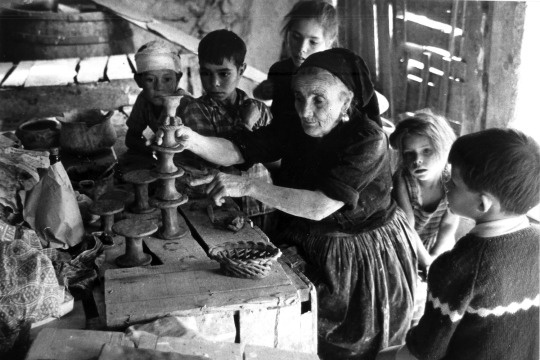

Rosa Ramalho (1888–1977) na sua oficina em S. Martinho de Galegos (Barcelos, Portugal), c. 1967. Foto Nancy Flowers/Jackson Legros. Arquivo Fotográfico do Museu de Olaria de Barcelos.
Rosa Barbosa Lopes nasce, a 14 de agosto de 1888, em S. Martinho de Galegos, sendo filha de Luís Lopes, sapateiro de profissão, e de Emília Barbosa, tecedeira. A alcunha Ramalho herda-a do pai e por ela será nomeada durante toda a vida. Com a morte do marido, a 17 de junho de 1956, Rosa passa a dedicar-se inteiramente à produção de figurado. Numa entrevista a Nancy Flowers afirma: «como tínhamos de viver, voltei-me para a argila».
Foi por esta altura, segunda metade da década de 1950, descoberta por António Quadros, iniciando-se assim uma nova fase produtiva. As elites cultas urbanas começam a frequentar a sua casa/oficina, a comprar e a divulgar a sua obra. Nesta FASE Ill o figurado de Rosa tem dois tipos de compradores: as crianças que o compram como divertimento e cedo os abandonam e os adultos que o exibem e conservam nas suas casas. [...] Toda a obra de Rosa é o resultado daquilo que aprendeu a fazer em menina, mas também há nela uma originalidade e criatividade que nos encanta, sendo na FASE III que ela começa a criar novas peças.
A juntar à originalidade das suas criações devemos acrescentar o corpo miúdo, a vivacidade no olhar, a resposta pronta e oportuna, o trajar de negro, o lenço na cabeça, o falar com os seus com a mesma destreza e liberdade com que fala com os que vêm da cidade para a conhecer. Tudo isto caraterísticas que a tornam singular.
Rosa Barbosa Lopes was born on 14 August 1888, in São Martinho de Galegos, the daughter of Luis Lopes, a cobbler, and Emília Barbosa, a weaver. Her nickname Ramalho was inherited from her father, and this became the name by which she was known throughout her life. When her husband died on 17 June 1956, Rosa began to devote herself entirely to the production of clay figures. In an interview with Nancy Flowers, she stated: «as we had to live, I went back to the clay.»
It was around this time, in the second half of the 1950s, that she was discovered by António Quadros, thus embarking upon a new phase of production. The educated urban elites began to frequent her house/workshop, buying and disseminating her work. In this PHASE III, Rosa's figures were purchased by two types of buyers: the children who bought them as toys and soon abandoned them; and the adults who exhibited them and kept them in their homes. [...] All of Rosa's work was the result of what she had learned to do as a child, but she also had her own delightful originality and creativity, and it was in this PHASE Ill of her work that she began to create new pieces.
Together with the originality of her creations, we should also mention the small, child-like size of her body, the liveliness of her gaze, the way in which she always had a ready and opportune answer to any question, the fact that she always dressed in black, the headscarf that she wore, and the way that she talked to those she knew with the same adroitness and freedom as she talked to those who came from the city to get to know her. All of these characteristics joined together made her a quite unique person.
“Rosa, viúva e bonecreira/Rosa, widow and dollmaker” in Rosa Ramalho: As Escolhas de um Colecionador [A Collector’s Choice]. Catálogo de exposição no Palácio da Cidadela de Cascais. Curadoria e textos de Isabel Maria Fernandes. Trad. John Eliott. Ed. Fundação D. Luís I, 2023.
5 notes
·
View notes